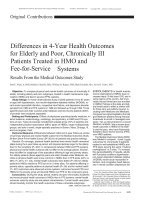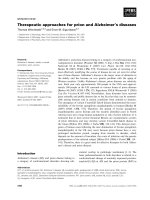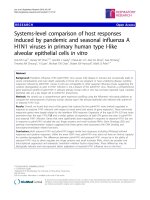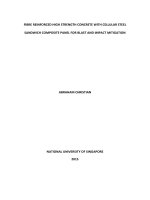Evaluation of host plant resistance for blast and brown spot diseases of paddy in hill zone of Karnataka, India
Bạn đang xem bản rút gọn của tài liệu. Xem và tải ngay bản đầy đủ của tài liệu tại đây (457.15 KB, 11 trang )
Int.J.Curr.Microbiol.App.Sci (2019) 8(3): 1294-1304
International Journal of Current Microbiology and Applied Sciences
ISSN: 2319-7706 Volume 8 Number 03 (2019)
Journal homepage:
Original Research Article
/>
Evaluation of Host Plant Resistance for Blast and Brown Spot Diseases of
Paddy in Hill Zone of Karnataka, India
G.N. Hosagoudar1*, Sheshaiah2, Basavaraj S. Kovi2 and B.S. Umesh Babu2
1
AICRIP on Rice, AHRS, Ponnampet, Karanataka, India-571 216
2
AHRS, Ponnampet, Karanataka, India-571 216
*Corresponding author
ABSTRACT
Keywords
Rice, Resistance,
Blast, Brown spot
and Diseases
Article Info
Accepted:
12 February 2019
Available Online:
10 March 2019
Rice (OryzasativaL.) is an important cereal crop belonging to the family Poaceae and has
two cultivated and 22 wild species. The cultivated species are Oryza sativa and
Oryzaglaberrima. Oryza sativa is grown all over the world. Rice is known to suffer from
number of diseases caused by fungal, bacterial and viral origins. Identification of resistant
genotypes is again an essential continuous process either to recommend for cultivation in
endemic area or to use as donors of the resistant genes. In view of these, the present
investigation of evaluation of 244 rice varieties/genotypes against leaf and neck blast and
brown spot diseases were carried out during Kharif 2014 at AHRS, Ponnampet to identify
the sources of resistance under field conditions. 244 entries were tested in Uniform blast
screening nursery for leaf blast and transplanted field of screening for neck blast and
brown spot diseases resistance of paddy, out of which a IET-23609 found highly resistant
to leaf blast disease of paddy and nine entries i.e. IET-23081, 23642, 23616, 23652, 23645,
23612, 23637, 23300, 23299showed resistant reactions to the leaf blast and remaining
entries were found moderately resistant to highly susceptible reaction to leaf blast. The
same entries were also screened for Neck blast disease out of which 38 entries i.e., IET23088, 23081, 23642, 23616, 23652, Swarna, 23627, 23645, 23612, 23654, 23275, 24132,
24151, 23224, 23758, 24116, 23739, 22654, 23052, 23055, 23053, 23601, 23599, 23594,
23591, 23004, 22986, 22989, Dinesh, 22302, 22994, 23422, 22878, 24074, 24167, Samba
Mahsuri (RP-1), Improved Samba Mahsuri (RP-2) and 23883 were found highly resistant,
remaining entries were found resistant to highly susceptible reaction to Neck blast.
Similarly, the same entries were also screened for brown spot disease out of which none of
the entries found highly resistance and 3 entries i.e., IET-23403, 22876 and 23392 were
found resistant reaction to brown spot disease. The remaining entries were found
moderately resistant to highly susceptible reaction to brown spot disease.
Introduction
Rice (OryzasativaL.) is an important cereal
crop belonging to the family Poaceae. Rice is
the most important staple food crop and grown
in India providing of 43 per cent of calorie
requirement for 70 per cent of the Indian
population. India is the largest rice growing
country accounting for about one third of the
world acreage under the crop. In India, annual
1294
Int.J.Curr.Microbiol.App.Sci (2019) 8(3): 1294-1304
rice production is 103.6 mt during 2016
(Anon, 2016). The major rice growing states
of India are West Bengal, Bihar, Madhya
Pradesh, Orissa, Andhra Pradesh, Karnataka
and Uttar Pradesh, which accounts 69.80 per
cent of the total area.
Rice suffers from many biotic and abiotic
factors which result in the lower productivity.
Among the biotic factor it suffer from fungal
diseases viz., blast (Pyricularia oryzae), brown
leaf
spot
(Bipolaris
oryzae
/
Helminthosporium
oryzae),
stem
rot
(Sclerotium
oryzae),
sheath
blight
(Rhizoctonia solani), sheath rot (Sarocladium
oryzae), bacterial disease such as bacterial
blight (Xanthomonas oryzaepv. oryzae) and
viral disease such as (rice tungro virus)
nematode disease such as rice root knot
(Meloidogyne graminicola) are important.
Among fungal diseases blast and brown spot
disease is of economic importance. In India,
the disease was first recorded in Thanjavore
delta of south India in 1918 by Mc Rae
(1922). However, it attracted the attention
only when a devastating epidemic occurred in
1919 (Padmanabhan, 1965). Among the
fungal disease, brown leaf spot of rice incited
by Helminthosporoum oryzae is a major
disease occurring in almost all the rice
growing areas of the world causing 5 per cent
yield loss across all lowland rice production
situations in south and Southeast Asia
(Savary, 2000).
The pathogen attacks all the aerial parts of
plants at any stage of crop growth right from
germination to harvest. The disease occurs as
seedling blight, leaf blast, node blast, neck or
panicle blast and grain spot. Seed and soil
borne infection during germination and
thereafter on tender seedling cause, seedling
blight leading to death of seedling. Leaf blast
is characterized by production of large spindle
shaped lesions with ashy grey centres with
brown margins drastically reduce crop growth
and tillering. The infected node or neck tissues
became soft and rotted. The node or neck blast
is considered as the most destructive phase of
the disease attacking prior or after flowering
and grain formation, causing drastic reduction
in grain quality and quantity of produce. The
infection on grain produced dark brownish
black spot.
Blast disease commonly occurs in few paddy
growing areas like Mandya, Kodagu,
Shivamogga, Uttara Kannada, Dakshina
Kannada, Mysore and Chickmagaluru districts
(Anon., 1981). The occurrence of disease in
moderate to severe form in hilly areas of
Karnataka is mainly due to indiscriminate use
of nitrogenous fertilizers, heavy rainfall,
mono-cropping and repeated cultivation of the
crop. This leads to severe losses in grain yield
of the crop. Moreover, repeated cultivation of
paddy would not only make the higher
inoculum build up but also aggravate the
disease problem.
Cultivation of resistant genotypes is the
effective and cheaper method to combat the
disease as compared to the chemical control.
Hence, several genotypes should be screened
to identify the resistant genotypes. In view of
these, the present investigation of evaluation
of 244 rice varieties/genotypes against blast
and brown spot diseases were carried out
during Kharif 2014 at AHRS, Ponnampet to
identify the sources of resistance under field
conditions.
Materials and Methods
Screening of rice genotypes against leaf
blast disease in Uniform Blast Nursery
(UBN) pattern
The experiment was conducted during Kharif
2014 at AHRS, Ponnampet. Screening of rice
against P. oryzae was carried out to know the
source of resistance against leaf blast disease
1295
Int.J.Curr.Microbiol.App.Sci (2019) 8(3): 1294-1304
under natural epiphytotic condition. 244 rice
germplasm lines were evaluated against leaf
blast disease. These germplasm lines were
sown on 07-07-2014 in UBN (Uniform Blast
Nursery) pattern. It is an identification of
naturally existing blast strains in the hotspot
locality. In this technique, nursery beds of 0.5
m width and length of 50 m were raised using
spade, all around the bed the most susceptible
checks were sown to serve as a source of
inoculums for spreading the disease. The
susceptible and resistant checks were sown
initially and each test entry were sown at 10
cm apart in one line and after every 20 test
entries again susceptible and resistant checks
were sown. Disease reactions were recorded
by using 0-9 scale given below.
Scoring for leaf blast was done at nursery stage by using following scale given by IRRI (1996)
Rating scale
0
1
2
3
4
5
6
7
8
9
Disease severity
No lesion observed
Small brown specks of pin point size
Small roundish to slightly elongated, necrotic grey
spots, about 1-2 mm in diameter, with a distinct brown
margin. Lesions are mostly found on the lower leaves
Lesion type same as in 2, but significant number of
lesions on the upper leaves
Typical susceptible blast lesions, 3 mm or longer
infecting less than 4% of leaf area
Typical susceptible blast lesions of 3mm or longer
infecting 4-10% of the leaf area
Typical susceptible blast lesions of 3 mm or longer
infecting 11-25% of the leaf area
Typical susceptible blast lesions of 3 mm or longer
infecting 26-50% of the leaf area
Typical susceptible blast lesions of 3 mm or longer
infecting 51-75% of the leaf area many leaves are dead
Typical susceptible blast lesions of 3 mm or longer
infecting more than 75% leaf area affected
Screening of rice genotypes against neck
blast and brown spot diseases in field
nursery pattern
Another experiment was conducted during
Kharif2014 at AHRS, Ponnampet. Screening
of
rice
against
P.
oryzae
and
Helminthosporium oryzae was carried out to
know the source of resistance against neck
blast and brown spot diseases under natural
epiphytotic condition. 244 rice germplasm
lines were evaluated against neck blast and
brown spot diseases. These germplasm lines
Host response
Highly Resistant
Resistant
Moderately
Resistant
Moderately
Resistant
Moderately
Susceptible
Moderately
Susceptible
Moderately
Susceptible
Susceptible
Highly
Susceptible
Highly
Susceptible
were sown on 01-07-2014 in field nursery
pattern. Intan and IR-64 serve as susceptible
and resistant check respectively. One line of
25 days old seedlings were uprooted from the
nursery bed and planted in the main field over
a length of 1.5 meters in two lines with a
spacing of 15 x 15 cm. Fertilizers were
applied at the rate of 75:75:90 Kg/ha i.e. basal
application at the rate of 37.5:75:45 Kg/ha and
top dressing of 37.5:0:45 Kg/ ha respectively.
The screening against neck blast and brown
spot resistance and disease reactions were
recorded using 0-9 scale given below.
1296
Int.J.Curr.Microbiol.App.Sci (2019) 8(3): 1294-1304
Scoring for neck blast was done at harvesting stage by using following scale given by IRRI
(1996)
Rating scale
0
1
3
5
7
9
Disease Reaction
HR
R
MR
MS
S
HS
Description
No incidence
Less than 5 % infected panicles
5-10 % infected panicles
11-25 % infected panicles
26-50 % infected panicles
More than 50 % infected panicles
Scoring for brown spot by using following scale given by IRRI (1996)
Rating scale
0
1
2
3
4
5
6
7
8
9
Disease severity in per
cent leaf area coverage
No incidence
Less than 1%
1-3%
4-5%
6-10%
11-15%
16-25%
26-50%
51-75%
76-100 %
Results and Discussion
Screening of rice genotypes against
blastand brown spot diseases in Nurseries
In order to identify the resistant sources, 244
rice genotypes were screened by using 0-9
scale against leaf and neck blast caused by P.
oryzae under natural epiphytotic condition at
AHRS, Ponnampet. The genotypes were
grouped into six classes based on degree of
reaction and the number of genotypes falling
in particular group and results are presented in
Table 1 and Plate 1 respectively.
Among 244 genotypes screened against leaf
blast, out of which a IET-23609 found highly
resistant to leaf blast disease of paddy, nine
entries i.e.,IET-23081, 23642, 23616, 23652,
Host response
Highly Resistant
Resistant
Moderately Resistant
Moderately Resistant
Moderately Susceptible
Moderately Susceptible
Moderately Susceptible
Susceptible
Highly Susceptible
Highly Susceptible
23645,
23612,
23637,
23300
and
23299showed resistant reactions to the leaf
blast, thirty one entries i.e.,IET-23088,
swarna, 23627, 23654, 23275, 23324, 23682,
23666, 23695, P A 6129, IET-24133, 23714,
23680, 23230, 23758, 23223, 24111, 1 R 64,
23216, 23831, 23834, 23345, Sahbhagidhan,
23341, 24075, 23356, 23977, 23983, 23949,
23979 and 23993 showed moderately resistant
reactions to the leaf blast. One hundred forty
eight entries i.e.,IET-23272, 23720, 23687,
24132, 24143, 24151, 24138, 23224, 24098,
24103, 24116, 23770, 24104, 24120, 24097,
24100, 23743, US 312, 22654, Kalanamak,
23203, 23830, 23824, IR 64, 23333, 22704,
23448, 23409, 23420, 22876, 23392, 2339,
24074, 23984, 23988, 23951, 24081, 24082,
2503, 2505, 2506,24576, 24577, PusaSugandh
5 (RP), Check Variety (HR-12, T (N)1), IET-
1297
Int.J.Curr.Microbiol.App.Sci (2019) 8(3): 1294-1304
24142, 24126, 24147, 24146, NDR 359,
23268, 23739, 23777, 23735, 24122, 24113,
23017, 23596, 23603, Jalmagna, 22302,
23193, Chittimuthyalu, 23832, Samba
Mahsuri, 23329, 23334, 23337, 24003, 24001,
C R Dhan 201, 23459, 23466, 23471,23422,
22878, Sahbhagidhan, 23435, P A 6129,
23947, 23354, 23976, 23996, 24565, 24566,
24567, 24572, Pusa Basmati 6 (RP),24575,
24578, Check Variety (IR-64 & IR-50),
24166, C 101 LAC (DP 2), 24164, 23878,
IET-22920, 23678, 23226, 22913, NDR 359,
23227, 24114, 24117, Sabita, 23053,
23004,23010, Dinesh, 23009, 22648, 23829,
Kalanamak, 22747, 23355, 24049, 24051,
PA6129, 23997, 24010, CR Dhan 201, 24008,
23450, 23449, 23455, 22716, 23427, 23412,
23429, 23417, 23425, 23982, 23992, 23957,
23806, 23362, 24569, 24570, 23805, Check
Variety
(CO-39,
CH-45),
24102,
SanbaMahsuri (RP1), Tetep (DP 1), 24232,
23864 and 23883 showed moderately
susceptible reactions to the leaf blast. Twenty
six entries i.e., IET-23235, 23052, 23601,
23599, 23594, 22986, 22989, 22994, 22649,
24056, 24035, 24038, 24016, 24037, 23467,
23445, 22770, 23421, 23959, 24571, 23804,
24573, Check Variety (Benibhog), 24099,
24167and 23879 showed susceptible reactions
to the leaf blast. Twenty five entries i.e., IET24093, 23055, 23591, 23194, Badshabhog,
23189, 24006, 24025, 24028, 24007, 24036,
23463, 23430, 23413, 23411, 24568, 23367,
24574, Check Varieties (Nidhi, Vikramarya,
Ajaya, Swarnadhan), Improved Samba
Mahsuri (RP 2), Taroari Basmati and Check
Variety
(RP-Bio-26)
showed
highly
susceptible reaction to leaf blast respectively
(Table 1).
Among 244 genotypes screened against neck
blast, out of which thirty eight entries i.e.,IET23088, 23081, 23642, 23616, 23652, Swarna,
23627, 23645, 23612, 23654, 23275, 24132,
24151, 23224, 23758, 24116, 23739, 22654,
23052, 23055, 23053, 23601, 23599, 23594,
23591, 23004, 22986, 22989, Dinesh, 22302,
22994, 23422, 22878, 24074, 24167, Samba
Mahsuri (RP-1), Improved Samba Mahsuri
(RP-2) and 23883found highly resistant to
neck blast disease of paddy, Fifty eight entries
i.e.,IET-23637, 23299, 23324, 23682, 23666,
23714, 24142, 22920, 24126, 23687, 24143,
24147, 24146, 23226, NDR-359, 23227,
23268, 23230, 24120, 24122, 24113, US-312,
23017, 23596, 23603, Jalmagna, 23010,
Badshabhog, 23189, 22649, Kalanamak,
23832, Samba Mahsuri, 23834, 23337, 23355,
PA-6129, 24006, 24028, 24007, 23445,
22716, PA-6129, 23982, 22876, 23976, PA6129, 24082, 24568, 23804, Check Variety
(Rasi, RP-Bio-226, CO-39, Benibhog), C101LAC (DP2), 24232, 23864 and 23879
showed resistant reactions to the neck
blast,Fifty eight entries i.e.,IET-23609, 23647,
23272, 23680, 23720, NDR-359, 23678,
23235, 22913, 23223, IR-64, 23770, 24100,
24114, 24093, 23743, 23735, 24117,
Purnendu, 23009, 22648, 23194, 23203, IR64, Chittimuthyalu, 23831, 23329, 23345,
24003, 24001, 22704, 23448, 23471, 23409,
23429, 23413, 23947, 23988, 24075, 23356,
22977, 23983, 23951, 23354, 23993, 24567,
24577, Check Variety (Nidhi, Vikramarya,
Ajay, Swarnadhan, CH-45, IR-50), 24102,
Tetep (DP-1), 24166, 24164 and 23878
showed moderately resistant reactions to the
neck blast.Seventy one entries i.e., IR-64,
IET-23300, 24133, 23695, 24138, 24098,
24103, 24111, 23777, 24104, 24097, 23216,
Sabita, 23193, 23830, 23834, 23829, 22747,
23333, Sahbhagidhan, 23334, 24049, 24051,
24056, 23997, 24010, 24038, 24025, 24016,
24036, 24037, 23463, 23467, 23450, 23449,
23466, 23455, 23427, Sahbhagidhan, 23420,
23435, 23425, 23411, 23959, 23392, 23984,
23341, 23992, 23996, 24081, 23949, 23957,
23806, 23362, 24562, 24563, 24564, 24565,
24566, 24570, 24571, Taroari Basmati, 23367,
23805, 24574, Pusa Basmati-6 (RP), 24576,
24578, Check Variety (IR-64, T(N)-1) and
24099 showed moderately susceptible
1298
Int.J.Curr.Microbiol.App.Sci (2019) 8(3): 1294-1304
reactions to the neck blast. Eighteen entries
i.e.,Kalanamak, IET-24035, CR Dhan-201,
24008, CR Dhan-201, 23459, 22770, 23355,
23417, 23430, 23421, 23339, 23979, 24569,
24572, 24573, 24575 and Pusa Sugandh-5
(RP) showed highly susceptible reaction to
neck blast respectively (Table 2 and Plate 2).
Intan served as susceptible check showed
highly susceptible and susceptible reaction to
leaf and neck blast respectively. IR-64 served
as resistant check showed moderately resistant
reactions against leaf and neck blast
respectively. To identify the resistant sources
against the any disease in order to breed
resistant varieties is of primary importance.
Wide response of rice genotypes against P.
oryzae has been earlier observed by various
workers (Nagaraju et al., 1991, Saifulla and
Manjunath, 1995 and Ghazanfar et al., 2009).
Saha (2004) reported that HR-12 showed
susceptibility to P. oryzae as observed in the
present study. Ravi et al., (1989) reported that
Jaya variety showed high degree of resistant to
the blast of rice. The results obtained in the
present study are supported by Naiket al.,
(2016) who reported that Intan and HR-12
showed highly susceptible reaction to blast of
rice, while Rasi and IR-64 recorded
moderately susceptible reaction to the blast of
rice. Barnwal et al., (2012) reported and used
C0-39 as susceptible variety to blast of rice in
experiment to evaluate fungicides.
Among 244 genotypes screened against brown
spot, out of which none of the entries found
highly resistant to brown spot disease of
paddy, three entries i.e.,IET-23403, 22876 and
23392 showed resistant reactions to the leaf
blast, Seventy entries i.e.,IET-22654, 23599,
Kalanamak, 23333, 23355, 24025, 23459,
23466, 23427, 22770, Sahbhagidhan, 23412,
23425, 23413, 23411, 23947, 23983, 23949,
23979, 24572, 23804, 24576, Check Variety
(HR-12, Rasi, IR-64, T(N)-1, CH-45), Samba
Mahsuri (RP-1), Tetep (DP-1), 24164, 24232,
IET-23739, 23052, 23055, 23053, 23601,
23594, 22986, 23010, 23194, Samba Mahsuri,
23834, 44049, 24051, 24008, 24028, 24016,
22704, 23449, 23420, 23435, 23421, 23959,
23339, 23984, 23341, 24562, 24568, 24569,
24570, 24571, Taroari Basmati,, 23367,
23805, 24575, Check Variety (Co-39,
Benibhog), 24167, C 101LAC(DP-2) and
Improved Samba Mahsuri (RP-2) showed
moderately resistant reactions to the brown
spot disease. One hundred thirty seven entries
i.e., IET-23642, 23645, 23637, 23714, 23272,
24147, 24146, 23224, 23227, 24098, 23223,
23216, 24100, 23017, 23004, 22989, Dinesh,
23203, 23830, 23831, 23829, 22747, 23345,
24038, CR Dhan-201, 24007, 24036, 23467,
23450, 23471, 23455, 23992, 23976, 23996,
24564, 24565, 24566, 24567, 24574, Check
Variety (RP-Bio-226), IET-23652, 23647,
23300, 24133, 23666, 22920, 24132, 24143,
23230, 24111, 24104, 24097, 24114, 24117,
Purnendu, 22302, 22994, 22648, 23824, IR64, 23329, 23997, 24037, 23463, 23445,
22704, 23448, 23422, 23409, 23417, PA6129, 23988, 23356, 23977, 23951, 23354,
23993, 23362, Pusa Basmati-6 (RP), Pusa
Sugandh-5 (RP), Check Variety (Vikramarya,
Ajaya, IR-50), 24099, 24102, 23864, 23878,
23879, IET-23616, 23609, 23612, 23654, IR64, 23275, 23682, 24126, 23720, 23687,
24151, 23695, 24138, 23678, 23268, 23758,
24116, 23770, 24093, 23743, 23735, 24122,
US-312, 23596, 23591, 23189, 22649, 23193,
23832, 23334, 23337, 24056, 24035, 24006,
24010, 24003, 24001, 22716, 23409, 23429,
23982, 24075, 24081, 23957, 23806, 24573,
24578, Check Variety (Nidhi) and 24166
showed moderately susceptible reactions to
the brown spot disease. Twenty seven entries
i.e., IET-23088, 23081, Swarna, 23299,
23324, 24142, 23680, 23226, 22913, 23227,
23777, 24120, 24113, Sabita, 23603,
Jalmagna,
Badshabhog,
Kalanamak,
Chittimuthyalu, Sahbhagidhan, PA-6129,
24074, PA-6129, 24082, 24563, 24577 and
23883 showed susceptible reactions to the
brown spot disease. Six entries i.e., IET-
1299
Int.J.Curr.Microbiol.App.Sci (2019) 8(3): 1294-1304
23627, NDR-359, 23235, NDR-359, 24103
and 23009showd highly susceptible reaction
to the brown spot disease respectively (Table
2 and Plate 2). Wide response of rice
genotypes against Helminthosporoum oryzae
has been earlier observed by various workers.
Table.1 Grouping of paddy genotypes based on their reaction to Leaf blast under Nursery (NSN1) conditions
Entry No. (IET)
Reaction
(SES 0-9
Scale)
0(HR)
1 (R)
2(MR)
3 (MR)
4 (MS)
5 (MS)
6 (MS)
7 (S)
8 (HS)
9 (HS)
(1) IET-23609
(9) IET-23081, 23642, 23616, 23652, 23645, 23612, 23637, 23300, 23299
(10) IET-23088, swarna, 23627, 23654, 23275, 23324, 23682, 23666, 23695, P A
6129
(21) IET-24133, 23714, 23680, 23230, 23758, 23223, 24111, 1 R 64, 23216,
23831, 23834, 23345, Sahbhagidhan, 23341, 24075, 23356, 23977, 23983, 23949,
23979, 23993
(46) IET-23272, 23720, 23687, 24132, 24143, 24151, 24138, 23224, 24098,
24103, 24116, 23770, 24104, 24120, 24097, 24100, 23743, US 312, 22654,
Kalanamak, 23203, 23830, 23824, IR 64, 23333, 22704, 23448, 23409, 23420,
22876, 23392, 2339, 24074, 23984, 23988, 23951, 24081, 24082, 2503, 2505,
2506,24576, 24577, PusaSugandh 5 (RP), Check Variety (HR-12, T (N)1)
(51) IET-24142, 24126, 24147, 24146, NDR 359, 23268, 23739, 23777, 23735,
24122, 24113, 23017, 23596, 23603, Jalmagna, 22302, 23193, Chittimuthyalu,
23832, Samba Mahsuri, 23329, 23334, 23337, 24003, 24001, C R Dhan 201,
23459, 23466, 23471,23422, 22878, Sahbhagidhan,23435, P A 6129, 23947,
23354, 23976, 23996, 24565, 24566, 24567, 24572, Pusa Basmati 6 (RP),24575,
24578, Check Variety (IR-64&IR-50), 24166, C 101 LAC (DP 2), 24164, 23878,
(51) IET-22920, 23678, 23226, 22913, NDR 359, 23227, 24114, 24117, Sabita,
23053,23004,23010,Dinesh,23009,22648,23829,Kalanamak,22747,23355,24049,2
4051,PA6129,23997,24010,CRDhan201,24008,23450,23449,23455,22716,23427,
23412,23429,23417,23425,23982,23992,23957,23806,23362,24569,24570,23805,
Check Variety (CO-39, CH-45), 24102,Sanba Mahsuri (RP1),Tetep (DP
1),24232,23864,23883,
(26) IET23235,23052,23601,23599,23594,22986,22989,22994,22649,24056,24035,24038,
24016,24037,23467,23445,22770,23421,23959,24571,23804,24573,Check Variety
(Benibhog), 24099,24167,23879,
(23)IET-24093, 23055, 23591, 23194, Badshabhog, 23189, 24006, 24025, 24028,
24007, 24036, 23463, 23430, 23413, 23411, 24568, 23367, 24574, Check Variety
(Nidhi, Vikramarya, Ajaya, Swarnadhan), Improved Samba Mahsuri (RP 2),
(2) Taroari Basmati, Check Variety (RP-Bio-26),
1300
Int.J.Curr.Microbiol.App.Sci (2019) 8(3): 1294-1304
Table.2 Grouping of paddy genotypes based on their reaction to neck blast & brown spot under
transplanted field conditions
Reaction
(SES 0-9
Scale)
0 (HR)
1 (R)
Entry No. (IET)
Neck blast
Brown spot
(38) IET-23088, 23081, 23642, 23616,
23652, Swarna, 23627, 23645, 23612, 23654,
23275, 24132, 24151, 23224, 23758, 24116,
23739, 22654, 23052, 23055, 23053, 23601,
23599, 23594, 23591, 23004, 22986, 22989,
Dinesh, 22302, 22994, 23422, 22878, 24074,
24167, Samba Mahsuri (RP-1), Improved
Samba Mahsuri (RP-2) and 23883
(58) IET-23637, 23299, 23324, 23682,
23666, 23714, 24142, 22920, 24126, 23687,
24143, 24147, 24146, 23226, NDR-359,
23227, 23268, 23230, 24120, 24122, 24113,
US-312, 23017, 23596, 23603, Jalmagna,
23010,
Badshabhog,
23189,
22649,
Kalanamak, 23832, Samba Mahsuri, 23834,
23337, 23355, PA-6129, 24006, 24028,
24007, 23445, 22716, PA-6129, 23982,
22876, 23976, PA-6129, 24082, 24568,
23804, Check Variety (Rasi, RP-Bio-226,
CO-39, Benibhog), C-101LAC (DP2),
24232, 23864 and 23879
2 (MR)
3 (MR)
(58) IET-23609, 23647, 23272, 23680,
23720, NDR-359, 23678, 23235, 22913,
23223, IR-64, 23770, 24100, 24114, 24093,
23743, 23735, 24117, Purnendu, 23009,
22648, 23194, 23203, IR-64, Chittimuthyalu,
23831, 23329, 23345, 24003, 24001, 22704,
23448, 23471, 23409, 23429, 23413, 23947,
23988, 24075, 23356, 22977, 23983, 23951,
23354, 23993, 24567, 24577, Check Variety
(Nidhi, Vikramarya, Ajay, Swarnadhan, CH45, IR-50), 24102, Tetep (DP-1), 24166,
24164 and 23878,
4 (MS)
5 (MS)
(71) IR-64, IET-23300, 24133, 23695,
24138, 24098, 24103, 24111, 23777, 24104,
24097, 23216, Sabita, 23193, 23830, 23834,
1301
-
(3) IET-23403, 22876 and 23392
(31) IET-22654, 23599, Kalanamak, 23333, 23355,
24025, 23459, 23466, 23427, 22770, Sahbhagidhan,
23412, 23425, 23413, 23411, 23947, 23983, 23949,
23979, 24572, 23804, 24576, Check Variety (HR12, Rasi, IR-64, T(N)-1, CH-45), Samba Mahsuri
(RP-1), Tetep (DP-1), 24164 and 24232
(39) IET-23739, 23052, 23055, 23053, 23601,
23594, 22986, 23010, 23194, Samba Mahsuri,
23834, 44049, 24051, 24008, 24028, 24016, 22704,
23449, 23420, 23435, 23421, 23959, 23339, 23984,
23341, 24562, 24568, 24569, 24570, 24571, Taroari
Basmati,, 23367, 23805, 24575, Check Variety (Co39, Benibhog), 24167, C 101LAC(DP-2) and
Improved Samba Mahsuri (RP-2),
(40) IET-23642, 23645, 23637, 23714, 23272,
24147, 24146, 23224, 23227, 24098, 23223, 23216,
24100, 23017, 23004, 22989, Dinesh, 23203,
23830, 23831, 23829, 22747, 23345, 24038, CR
Dhan-201, 24007, 24036, 23467, 23450, 23471,
23455, 23992, 23976, 23996, 24564, 24565, 24566,
24567, 24574 and Check Variety (RP-Bio-226)
(48) IET-23652, 23647, 23300, 24133, 23666,
22920, 24132, 24143, 23230, 24111, 24104, 24097,
24114, 24117, Purnendu, 22302, 22994, 22648,
Int.J.Curr.Microbiol.App.Sci (2019) 8(3): 1294-1304
23829, 22747, 23333, Sahbhagidhan, 23334,
24049, 24051, 24056, 23997, 24010, 24038,
24025, 24016, 24036, 24037, 23463, 23467,
23450, 23449, 23466, 23455, 23427,
Sahbhagidhan, 23420, 23435, 23425, 23411,
23959, 23392, 23984, 23341, 23992, 23996,
24081, 23949, 23957, 23806, 23362, 24562,
24563, 24564, 24565, 24566, 24570, 24571,
Taroari Basmati, 23367, 23805, 24574, Pusa
Basmati-6 (RP), 24576, 24578, Check
Variety (IR-64, T(N)-1) and 24099
6 (MS)
7 (S)
-
8 (HS)
9 (HS)
(18) Kalanamak, IET-24035, CR Dhan-201,
24008, CR Dhan-201, 23459, 22770, 23355,
23417, 23430, 23421, 23339, 23979, 24569,
24572, 24573, 24575 and Pusa Sugandh-5
(RP)
23824, IR-64, 23329, 23997, 24037, 23463, 23445,
22704, 23448, 23422, 23409, 23417, PA-6129,
23988, 23356, 23977, 23951, 23354, 23993, 23362,
Pusa Basmati-6 (RP), Pusa Sugandh-5 (RP), Check
Variety (Vikramarya, Ajaya, IR-50), 24099, 24102,
23864, 23878 and 23879
(49) IET-23616, 23609, 23612, 23654, IR-64,
23275, 23682, 24126, 23720, 23687, 24151, 23695,
24138, 23678, 23268, 23758, 24116, 23770, 24093,
23743, 23735, 24122, US-312, 23596, 23591,
23189, 22649, 23193, 23832, 23334, 23337, 24056,
24035, 24006, 24010, 24003, 24001, 22716, 23409,
23429, 23982, 24075, 24081, 23957, 23806, 24573,
24578, Check Variety (Nidhi) and 24166
(27) IET-23088, 23081, Swarna, 23299, 23324,
24142, 23680, 23226, 22913, 23227, 23777, 24120,
24113, Sabita, 23603, Jalmagna, Badshabhog,
Kalanamak, Chittimuthyalu, Sahbhagidhan, PA6129, 24074, PA-6129, 24082, 24563, 24577 and
23883
(6) IET-23627, NDR-359, 23235, NDR-359, 24103
and 23009
-
Plate.1 screening of rice genotypes against leaf blast disease in Uniform Blast Nursery (UBN)
pattern
1302
Int.J.Curr.Microbiol.App.Sci (2019) 8(3): 1294-1304
Plate.2 screening of rice genotypes against neck blast and brown spot diseases in field nursery
Arshad et al., (2008) were evaluated seventy
genotypes/entries/varieties, among that only
one Basmati entry, PK-3699-43 of PARC was
found resistant, while all other remaining
varieties/entries were found moderately
resistant to highly susceptible.
Mother et al., (2013) screened five rice
cultivars, one hybrid (WR96), three modern
(BR16, BR26, and BRRI Dhan27) and one
local (Pari) were screened for their reaction to
brown leaf spot disease caused by
Cochliobolus
miyabeanus
and
their
performance on yield-related characters. The
severity of brown leaf spot varied with growth
stages of rice plant as well as different
cultivars tested under field condition. Low
disease severity was observed at maximum
tillering stage compared to moderate to high
at dough stage, with hybrid cultivar WR96
showing highest disease, while local cultivar
Pari had the lowest.
References
Anonymous, 1981, Package of practices for
high yields. Univ. Agric. Sci.
Bangalore.
Anonymous, 2016, Statistical database.
Barnwal, M. K., Vaibhav, K. S., Sharma, R.
B. and Singh, B. N., 2012, Field
evaluation of rice genotypes for
resistance and new fungicides for
control of blast (Pyricularia oryzae).
Indian Phytopathol., 65(1): 56-59.
Ghazanfar, M. U., Wakil, W., Sahi, S. T. and
Yasin, S., 2009, Influence of various
fungicides on the management of rice
blast disease. Mycopath, 7(1): 29-34.
International Rice Research Institute (IRRI),
1996, Standard evaluation system for
rice. 4th.ed. IRRI, Manila, Phillipine.
Mcrae, W., 1922, Report of the Imperial
Mycologist Scientific Report, Pusa
Agricultural Research Institute, p. 4450.
Nagaraju, P., Vasantakumar, H. C., Devaiah,
B. M., Seshadri, V. S. and Naidu, B. S.,
1991, Evaluation of rice genotypes for
blast and sheath rot resistance in hilly
regions of Karnataka, Mysore J. Agric.
Sci., 25: 139-141.
Naik, G. R., Dinesh, K. M., Naik, G. B. and
Naik, B. T., 2016, Field evaluation of
high yielding and local paddy cultivars
of farmers seeds source in southern
transitional zone (zone-7) of Karnataka
against blast disease. I.J.A.B.R., 6(1):
21-24.
Padmanabhan, S. Y., 1965, Breeding for blast
resistance in India. In ‘The rice blast
disease’, Ed. Johns Hopkins Press,
Baltimore and Maryland, USA, pp. 203-
1303
Int.J.Curr.Microbiol.App.Sci (2019) 8(3): 1294-1304
221.
Ravi, K., Mishra, R. P. and Diwakar, M. C.,
1989, Field reaction of some varieties to
blast in Karnataka., Pl. Prot. Bull.,
Faridabad, 4: 13-14.
Saha, S., 2004, Behavior of rice varieties
against leaf blast disease in rainfed
upland conditions of West Bengal. J.
Mycopathol. Res., 42(2): 205-206.
Saifulla, M. and Manjunath, A., 1995,
Assessment of rice genotypes to blast
disease. Agric. Sci. Dig., 15: 151-152.
Arshad, H. M. I., Khan, J. A. and Jamil, F.F.,
2008, Screening of rice germplasm
against blast and brown spot disease.
Pak. J.Phytopathol., 20(1): 52-57.
Savary, R. A., 1959, Nomenclature of
Drechslera and Bipolaris, grass
parasites
segregated
from
Helminthosporium candisian J.Bot.,
37:879-87.
How to cite this article:
Hosagoudar, G.N., Sheshaiah, Basavaraj S. Kovi and Umesh Babu, B.S. 2019. Evaluation of
Host Plant Resistance for Blast and Brown Spot Diseases of Paddy in Hill Zone of Karnataka,
India. Int.J.Curr.Microbiol.App.Sci. 8(03): 1294-1304.
doi: />
1304









